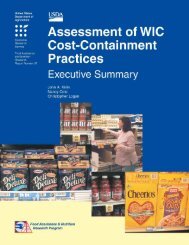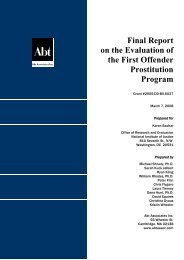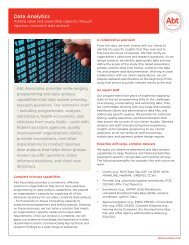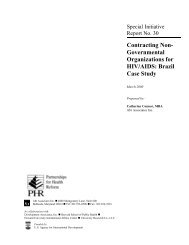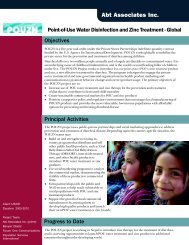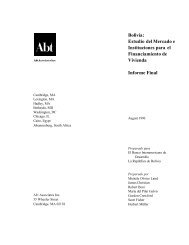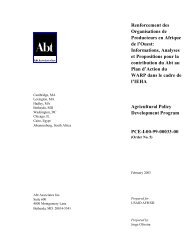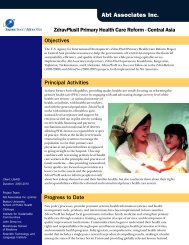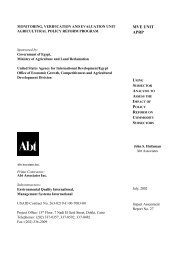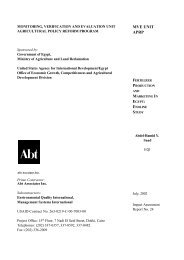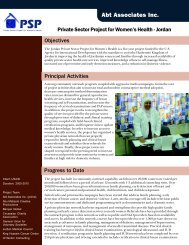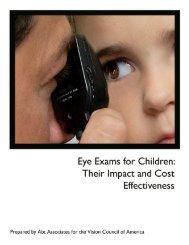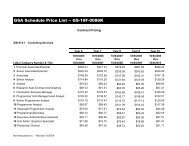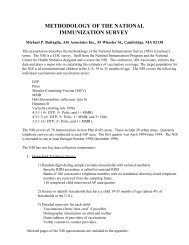What America's Users Spend on Illegal Drugs 1988-2000 - National ...
What America's Users Spend on Illegal Drugs 1988-2000 - National ...
What America's Users Spend on Illegal Drugs 1988-2000 - National ...
- No tags were found...
Create successful ePaper yourself
Turn your PDF publications into a flip-book with our unique Google optimized e-Paper software.
known about drug producti<strong>on</strong> and c<strong>on</strong>sumpti<strong>on</strong> and what needs to be known to better understand the policychoices available to the Nati<strong>on</strong>. Indeed, a comparis<strong>on</strong> of this report with its precursors for earlier yearsreveals the truth of this statement. Each new versi<strong>on</strong> of <str<strong>on</strong>g>What</str<strong>on</strong>g> America’s <str<strong>on</strong>g>Users</str<strong>on</strong>g> <str<strong>on</strong>g>Spend</str<strong>on</strong>g> <strong>on</strong> Illicit <strong>Drugs</strong> hashad access to better data and improved estimati<strong>on</strong> methodology. In turn, each new versi<strong>on</strong> has providedrevised estimates of the number of users, the amount they spend <strong>on</strong> illicit drugs, and the amount of drugsthey use. Year-to-year changes in these estimates must be unsettling to this report’s users, but we hopethose readers can appreciate that the methodology has evolved over time, and the price of inc<strong>on</strong>sistencyhas been year-to-year improvements.We make no pretense here that the model and estimates we present in this report are fully adequate to thelarger task of informing public policy decisi<strong>on</strong>s. They are, at best, a start, but they offer importantpossibilities of integrating what are otherwise seen as disparate pieces of informati<strong>on</strong> about thec<strong>on</strong>sumpti<strong>on</strong> and supply of drugs.We expect incremental improvements to the estimates and methods offered here, particularly as better databecome available. We also expect improvement in the models. In fact, the Office of Nati<strong>on</strong>al DrugC<strong>on</strong>trol Policy has started a project to improve and integrate drug use and supply indicator data. TheNati<strong>on</strong>al Institute of Justice, through its Arrestee Drug Abuse M<strong>on</strong>itoring program, has instituted projectsto more accurately estimate the number of chr<strong>on</strong>ic drug users and to better describe illicit drug markets.Also, the Substance Abuse Mental Health Services Administrati<strong>on</strong>s, through the NHSDA, is implementingan important series of questi<strong>on</strong>s about marijuana purchasing practices. These emerging data will greatlyimprove future versi<strong>on</strong>s of these estimates.Moreover, the estimates by themselves have <strong>on</strong>ly modest importance: they tell us nothing more than thatthe drug trade is large, a c<strong>on</strong>clusi<strong>on</strong> that requires no special study. The real utility of these numbers is thedevelopment of a systematic methodology for integrating the various indicators (crops in foreign countries,drugs seized at the borders, arrests made in American cities, etc.) that can help policymakers to betterunderstand the dynamics of the drug trade and to fashi<strong>on</strong> appropriate policy resp<strong>on</strong>ses.The current process for integrating this research into policymaker decisi<strong>on</strong>s is through the ONDCPPerformance Measure of Effectiveness (PME) system. The PMEs set 97 performance targets and 127associated measures. Many of these targets involve supply-side activity, such as reducti<strong>on</strong> of heroin flow34



